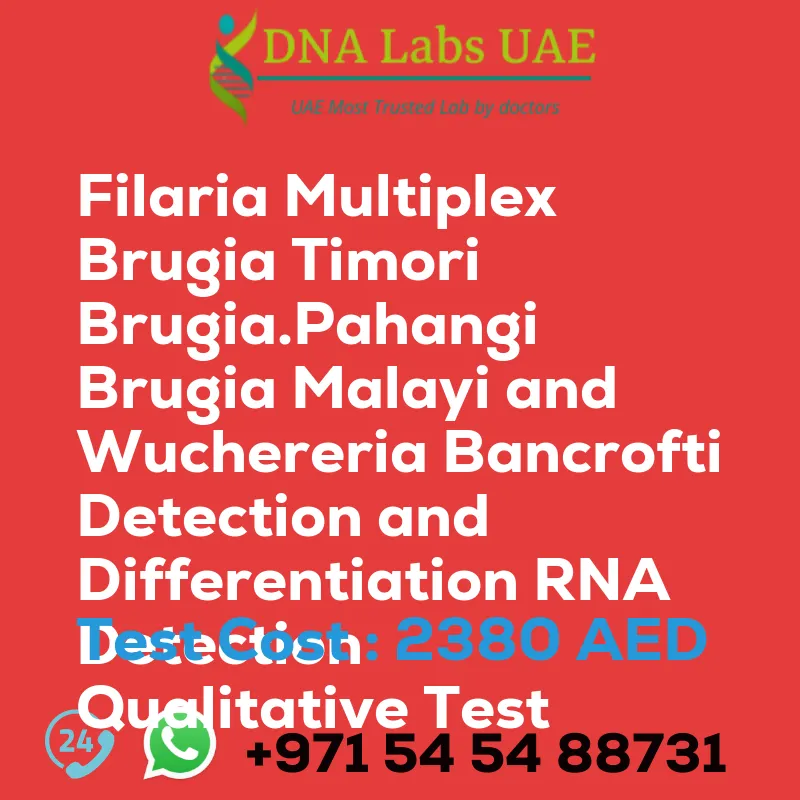Filaria Multiplex Brugia timori Brugia.pahangiBrugia malayi and Wuchereria bancrofti detection and differentiation RNA Detection Qualitative Test
Test Name: Filaria Multiplex Brugia timori Brugia.pahangiBrugia malayi and Wuchereria bancrofti detection and differentiation RNA Detection Qualitative Test
Components: Whole blood, Biopsies
Price: 2380.0 AED
Sample Condition: Whole blood, Biopsies
Report Delivery: 4th Working Day Email: 48 hours, On phone: 36 hours
Method: Real Time PCR
Test Type: Viral
Doctor: Physician
Test Department: Genetics
Pre Test Information: Need to sign Consent document and bring any clinical history of patient for Filaria Multiplex (Brugia timori, Brugia.pahangi, Brugia malayi and Wuchereria bancrofti) detection & differentiation (RNA Detection) Qualitative Test
Test Details
RNA detection is a qualitative test used to detect and differentiate different species of Filaria, including Brugia timori, Brugia pahangi, Brugia malayi, and Wuchereria bancrofti. This test is based on the detection of specific RNA molecules that are unique to each species. The test involves the following steps:
- Sample collection: A blood sample is collected from the patient suspected of having a filarial infection. The sample is usually collected in EDTA tubes to prevent clotting.
- RNA extraction: The RNA is extracted from the blood sample using a specialized RNA extraction kit. This step involves breaking open the blood cells and isolating the RNA molecules.
- Reverse transcription: The extracted RNA is then reverse transcribed into complementary DNA (cDNA) using reverse transcriptase enzyme. This step converts the RNA molecules into DNA for further analysis.
- Polymerase chain reaction (PCR): The cDNA is then amplified using specific primers that target the RNA molecules unique to each species of Filaria. PCR is a technique that allows for the amplification of specific DNA sequences.
- Gel electrophoresis: The amplified DNA fragments are separated by size using gel electrophoresis. This technique involves applying an electric current to the gel, causing the DNA fragments to migrate through the gel based on their size. The separated fragments are then visualized using a DNA stain.
- Result interpretation: The presence or absence of specific DNA bands on the gel indicates the presence or absence of the corresponding Filaria species. Each species will have a unique pattern of DNA bands, allowing for differentiation between them.
Overall, RNA detection using PCR and gel electrophoresis is a sensitive and specific method for the qualitative detection and differentiation of Filaria species. It can help in the diagnosis and surveillance of filarial infections, allowing for appropriate treatment and control measures.
| Test Name | Filaria Multiplex Brugia timori Brugia.pahangiBrugia malayi and Wuchereria bancrofti detection and differentiation RNA Detection Qualitative Test |
|---|---|
| Components | |
| Price | 2380.0 AED |
| Sample Condition | Whole blood., Biopsies |
| Report Delivery | 4th Working Day Email : 48 hours.On phone : 36 hours |
| Method | Real Time PCR |
| Test type | Viral |
| Doctor | Physician |
| Test Department: | Genetics |
| Pre Test Information | Need to sign Consent document and bring any clinical history of patient forFilaria Multiplex (Brugia timori, Brugia.pahangi,Brugia malayi and Wuchereria bancrofti ) detection & differentiation (RNA Detection) QualitativeTest |
| Test Details |
RNA detection is a qualitative test used to detect and differentiate different species of Filaria, including Brugia timori, Brugia pahangi, Brugia malayi, and Wuchereria bancrofti. This test is based on the detection of specific RNA molecules that are unique to each species. The test involves the following steps: 1. Sample collection: A blood sample is collected from the patient suspected of having a filarial infection. The sample is usually collected in EDTA tubes to prevent clotting. 2. RNA extraction: The RNA is extracted from the blood sample using a specialized RNA extraction kit. This step involves breaking open the blood cells and isolating the RNA molecules. 3. Reverse transcription: The extracted RNA is then reverse transcribed into complementary DNA (cDNA) using reverse transcriptase enzyme. This step converts the RNA molecules into DNA for further analysis. 4. Polymerase chain reaction (PCR): The cDNA is then amplified using specific primers that target the RNA molecules unique to each species of Filaria. PCR is a technique that allows for the amplification of specific DNA sequences. 5. Gel electrophoresis: The amplified DNA fragments are separated by size using gel electrophoresis. This technique involves applying an electric current to the gel, causing the DNA fragments to migrate through the gel based on their size. The separated fragments are then visualized using a DNA stain. 6. Result interpretation: The presence or absence of specific DNA bands on the gel indicates the presence or absence of the corresponding Filaria species. Each species will have a unique pattern of DNA bands, allowing for differentiation between them. Overall, RNA detection using PCR and gel electrophoresis is a sensitive and specific method for the qualitative detection and differentiation of Filaria species. It can help in the diagnosis and surveillance of filarial infections, allowing for appropriate treatment and control measures. |








